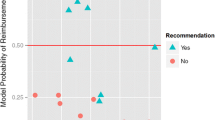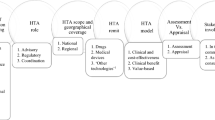Abstract
Introduction
Health technology assessment (HTA) aims to provide a transparent framework within which normative judgements can be applied for decision making. Such transparency enables the public to understand the rationale for decision making, but conflicts with companies being able to offer commercially sensitive discounts. We investigated how to balance these conflicting ideals.
Methods
National Institute for Health and Care Excellence (NICE) submissions were reviewed for products with an approved, simple Patient Access Scheme (PAS) discount. The approach to censoring was noted (e.g. total cost and clinical outcomes redacted). Submissions were then assessed for transparency (i.e. whether the decision appeared justifiable given the available information) and confidentiality (i.e. whether the PAS discount could be ‘back calculated’).
Results
One hundred and eighteen products have an approved commercial arrangement, of which 110 have simple PAS discounts considered within the NICE Single Technology Appraisal programme. A definitive incremental cost-effectiveness ratio was presented within final NICE guidance in only 20 appraisals. Documentation for seven appraisals allowed for the straightforward ‘back calculation’ of PAS discounts. Furthermore, a large amount of information was censored as academic-in-confidence and remains so many years later.
Conclusion
Appropriate redaction ensures discounts remain confidential, yet maintains the transparency of the HTA decisions made. Complete redaction does not allow for transparent, justifiable decision making. However, redacting ‘enough’ information to preclude direct estimation of discounts provides a means of maintaining both transparency and confidentiality. This study demonstrates a lack of consensus regarding presentation of results, and the importance of appropriate redaction.


Similar content being viewed by others
References
National Institute for Health and Care Excellence (NICE). Patient Access Scheme Liaison Unit [Internet]. 2018. https://www.nice.org.uk/about/what-we-do/patient-access-schemes-liaison-unit. Accessed 02 Nov 2018.
National Institute for Health and Care Excellence (NICE). List of recommended technologies that include a commercial arrangement [Internet]. 2018. https://www.nice.org.uk/About/What-we-do/Patient-access-schemes-liaison-unit/List-of-technologies-with-approved-Patient-Access-Schemes. Accessed 02 Nov 2018.
National Institute for Health and Care Excellence (NICE). Guide to the methods of technology appraisal 2013 [Internet]. 2013. https://www.nice.org.uk/process/pmg9/resources/guide-to-the-methods-of-technology-appraisal-2013-pdf-2007975843781. Accessed 02 Nov 2018.
National Institute for Health and Care Excellence (NICE). Guide to the processes of technology appraisal [Internet]. 2014. https://www.nice.org.uk/process/pmg19/resources/guide-to-the-processes-of-technology-appraisal-pdf-72286663351237. Accessed 02 Nov 2018.
National Institute for Health and Care Excellence (NICE). Appraising life-extending, end of life treatments [Internet]. 2009. https://www.nice.org.uk/guidance/gid-tag387/documents/appraising-life-extending-end-of-life-treatments-paper2. Accessed 18 Jan 2019.
National Institute for Health and Care Excellence (NICE). Agreement between the Association of the British Pharmaceutical Industry (ABPI) and the National Institute for Health and Clinical Excellence (NICE) on guidelines for the release of company data into the public domain during a health technology appraisal [Internet]. https://www.nice.org.uk/Media/Default/About/what-we-do/NICE-guidance/NICE-technology-appraisals/Guidelines-for-the-release-of-company-data-into-the%20public-domain-during-a-health-technology-appraisal.pdf. Accessed 09 Jan 2019.
National Institute for Health and Care Excellence (NICE). TA552 Committee papers: liposomal cytarabine and daunorubicin for untreated acute myeloid leukaemia [Internet]. Comm. Pap. 2018. https://www.nice.org.uk/guidance/ta552/documents/committee-papers. Accessed 30 Apr 2019.
Lancet JE, Uy GL, Cortes JE, Newell LF, Lin TL, Ritchie EK, et al. CPX-351 (cytarabine and daunorubicin) liposome for injection versus conventional cytarabine plus daunorubicin in older patients with newly diagnosed secondary acute myeloid leukemia. J Clin Oncol Off J Am Soc Clin Oncol. 2018;36:2684–92.
National Institute for Health and Care Excellence (NICE). TA552 Final Appraisal Determination: Liposomal cytarabine and daunorubicin for untreated acute myeloid leukaemia [Internet]. 2018. https://www.nice.org.uk/guidance/ta552/documents/html-content-3. Accessed 30 Apr 2019.
Ozierański P, Löblová O, Nicholls N, Csanádi M, Kaló Z, McKee M, et al. Transparency in practice: Evidence from “verification analyses” issued by the Polish Agency for Health Technology Assessment in 2012–2015. Health Econ Policy Law. 2019;14:182–204.
National Institute for Health and Care Excellence (NICE). TA401 Committee papers: Bosutinib for previously treated chronic myeloid leukaemia [Internet]. 2016. https://www.nice.org.uk/guidance/ta401/history. Accessed 21 Jan 2019
National Institute for Health and Care Excellence (NICE). TA480 Committee papers: Tofacitinib for moderate to severe rheumatoid arthritis [Internet]. 2017. https://www.nice.org.uk/guidance/ta480/history. Accessed 21 Jan 2019
National Institute for Health and Care Excellence (NICE). TA339 Evaluation Report and Supporting Information: Omalizumab for previously treated chronic spontaneous urticaria [Internet]. 2014. https://www.nice.org.uk/guidance/ta339/history. Accessed 21 Jan 2019
National Institute for Health and Care Excellence (NICE). TA523 Committee papers: Midostaurin for untreated acute myeloid leukaemia [Internet]. 2018. https://www.nice.org.uk/guidance/ta523/history. Accessed 21 Jan 2019
Author information
Authors and Affiliations
Contributions
AH and MT conceived the paper. AB, SM and EW carried out data extraction and data analysis. The paper was drafted by AB, AH and MT. All authors contributed to the draft of the paper and addressed comments from the reviewers.
Corresponding author
Ethics declarations
Funding
No funding was received for this manuscript.
Conflict of interest
AB, MT, STM, EW and AJH declare that they have no conflicts of interest.
Data Availability
All data were taken from the website of the National Institute for Health and Care Excellence (NICE), and are in the public domain.
Rights and permissions
About this article
Cite this article
Bullement, A., Taylor, M., McMordie, S.T. et al. NICE, in Confidence: An Assessment of Redaction to Obscure Confidential Information in Single Technology Appraisals by the National Institute for Health and Care Excellence. PharmacoEconomics 37, 1383–1390 (2019). https://doi.org/10.1007/s40273-019-00818-0
Published:
Issue Date:
DOI: https://doi.org/10.1007/s40273-019-00818-0




